Naginata For Sale
Since ancient times, naginatas have served as a traditional Japanese pole weapon The samurai and onna-bugeisha or female warriors utilized it for centuries. Above being a weapon, the naginata serves as a symbol of skill and traditions that people view as an art piece.
The weapon’s broad, curved blade makes slicing in both attack and defense effortless while also providing a considerable radius for fighters during battle. Due to its intricate design, its detailed ties to Japanese culture, and its well-known craftsmanship, naginatas are revered among collectors. High carbon steel which is used to make the blade, strengthens and preserves its sharpness. Numerous naginatas are hand-forged, which speaks of the remarkable craftsmanship.
The weapon not only enhances the value of martial arts but also serves as a historical weapon with artistic prowess. Be it for combat or part of a collection, the naginata is renowned for its striking quality and sophisticated, yet thoughtful fabric in Japanese cultural history.
Naginata - The Ultimate Elegant Japanese Sword
The Naginata’s graceful design mirrors the history of Samurai warriors and Japan itself. This piece of artillery was used in battle and later switched to a piece of training equipment, engraved into martial arts. The Naginata was primarily seized by Samurai, and wielded by female Japanese warriors known as ‘Onna-bugeisha.’ Recognized for its historical importance, The Naginata is still used and admired today.
Used in the Katori Shinto Ryu martial school, known for associating physical ability with spiritual awareness, the Naginata teaches slashing, stabbing, and sweeping movements, enabling timing, balance, strength, and focus to be incorporated. Practicing with the Naginata serves as a way to connect with the traditions of Japan and enables exercise to be sculpted alongside history. The blades of the naginata are fashioned from high-carbon steel due to their strength, sharpness, and durability. Some blades are etched with designs or markings, enhancing their appeal and distinctiveness. The scabbard, or saya, is crafted from wood, which serves as a protective sheath when not in use. Both the blade and the scabbard portray stunning artistry and skill in the craftsmanship that goes into creating each naginata.
The history behind naginata’s design is an appealing aspect for collectors; they are very proud of each different piece. Some naginata were and still are meticulously forged by hand by expert swordsmiths, which makes them very expensive, although very esteemed. For admirers not looking to spend so much, there are cheaper replicas available.
Caring for a naginata is relatively easy. It simply needs to be cleaned and oiled regularly to stave off rust. It doesn’t require constant attention, but like any sharp weapon, a naginata should be treated with care during transport and storage. Given the proper handling and maintenance, a naginata can be a cherished piece in any collection, as it can be passed down for generations.
When purchasing a naginata, pay attention to the craftsmanship and materials used. Regardless if your intention is to practice martial arts with it or add it to your collection, there are numerous options available for various budgets and interests. Enthusiasts will not be disappointed, as there are exquisite naginata made with great attention to detail and even ornamental ones.
Ultimately, a naginata is not just a weapon, but an embodiment of the samurai spirit and Japanese artistic swordsmanship. Its historical significance, graceful form, functional purpose, energizes martial artists and collectors globally.
Naginata - The Ultimate Elegant Japanese Sword
If it's grace and style you seek in a Japanese sword, the naginata will capture your interest. This archetypal polearm is characterized by its wooden haft and long slashing blade, which is lethal yet beautiful. The naginata was also known as a 'reaping sword' because of its sweeping striking ability. The weapon’s construction highlights balance, definition, and craftsmanship, which makes it a lethal weapon and a work of art simultaneously.
The cutting edge of some naginata blades can extend to almost three feet, providing the wielder with exceptional reach. Continue reading to learn more about this unique and intriguing piece of Japanese sword history.
Origin of Naginata
Though its precise timeline is debated by scholars, the naginata was quite evidently pivotal to Japanese aristocratic society by the 10th century. The multifunctionality of Japanese naginata arising from their sword-making expertise enabled it to be designed for close and long-ranged combat as well as being effective against foot soldiers, cavalry, and infantry. Everything from the places and conditions of its manufacturing to the fabrication processes employed highly determines its effectiveness and adaptability to different situations.
It signifies huge marksmanship in the hands of onna musha, female warriors of Japan. The naginata gave them extreme control, empowering housewives, enabling them to safeguard their homes and kids with deadly efficiency. Each naginata embodies the skills of its martial masters, reflecting deep-rooted values of samurai culture etched around honor, strength, and protection.
Today, people treasure naginata blades not just because of the historical accounts they tell, but for the nurturing spirit latent within. Its design is remarkably enduring – over the course of history, there have been few changes made to it.
Naginata Today
If you’re looking to add a naginata to your collection, you’re in the right place. But it’s important to know that the naginata is not just a weapon—it’s also used to teach martial arts values like respect, self-confidence, elegance, and control.
Through consistent practice, martial artists learn how to use the weapon while also gaining a deeper spiritual connection to its history and tradition. Training in Japanese combat styles, especially Naginata, helps warriors develop discipline and focus—qualities that are highly valuable in today’s world. Naginatajutsu, a martial art focused on mastering the naginata, emphasizes precise routines and fluid movements.
The naginata also symbolizes integrity and chivalry, making it a meaningful gift for friends or family members you admire.
Our Naginata Collection
Authentic naginata swords have their blades honed and affixed on a long shaft for balance. Our company offers unrivaled customer service, ensuring your satisfaction while earning your trust in us as Japanese sword merchants. The blade's curvature is katana-like but not as slender, and thus provides a greater area for cutting. The naginata's long shaft and blade give it a refined appearance and aid in cutting due to its long pole. The collection is complete with exceptional pieces blended with tradition, made using high-quality hand-forged pieces of carbon steel. All buyers looking for a naginata for sale would be struck by its perfect balance of weight, agility, and design.
Different Types of Naginata Swords
The naginata is a well-known and highly regarded Japanese sword which has undergone some alterations through history. Each variation has a unique purpose whether it is for combat or practice, differing in design and material. Every sword tells a story of the nobility and skillful artistry done by the Japanese warrior craftsmen who made them. A naginata sword’s tsuba, also called guard, needs to be properly fitted and secured due to its significant impact on how the weapon is used or viewed. Here is a brief overview of naginata swords which we may have in stock.
Konaginata
The Konaginata is a shorter version of the traditional naginata, with both the handle and blade measuring around 30 inches. During the hardening process, a crystalline structure forms along the cutting edge, showcasing the craftsmanship and unique properties of the blade. Because it is shorter, the Konaginata isn’t as commonly used as other types.
Traditional Konaginata swords are rare, making them difficult to find, and many collectors struggle to track down authentic pieces.
Onaginata
The Onaginata is a longer version of the already long naginata, with a maximum length of nearly ten feet. Japanese warriors used the Onaginata in crowded battlefields because of its extended reach. However, due to its size and weight, the Onaginata is much heavier than a typical sword and requires a strong warrior to wield it effectively.
Double-edged Naginata
The double-edged naginata is used in performance acts by Japanese monks rather than in battle. It looks even more impressive in person than in online pictures, as the visual representation may not fully capture its quality and artistry. Featuring blades on both sides of the handle, this rare weapon is difficult to find for individual collections.
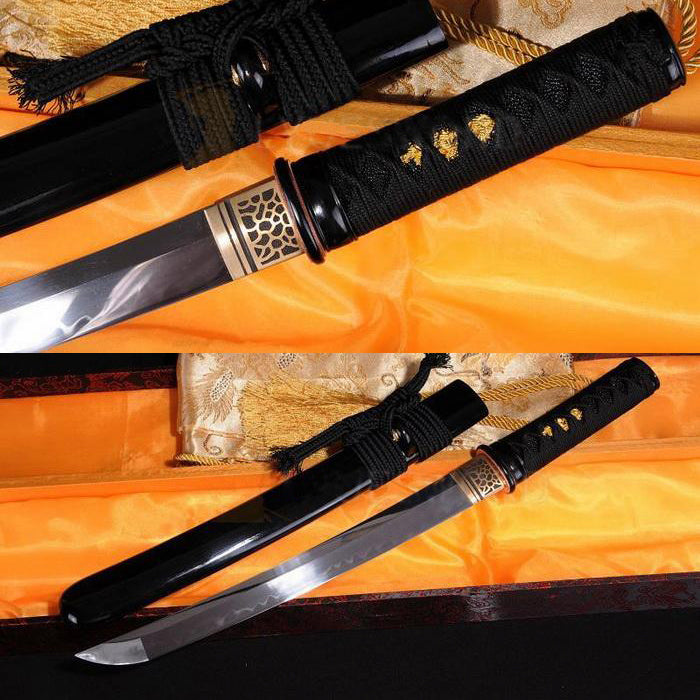
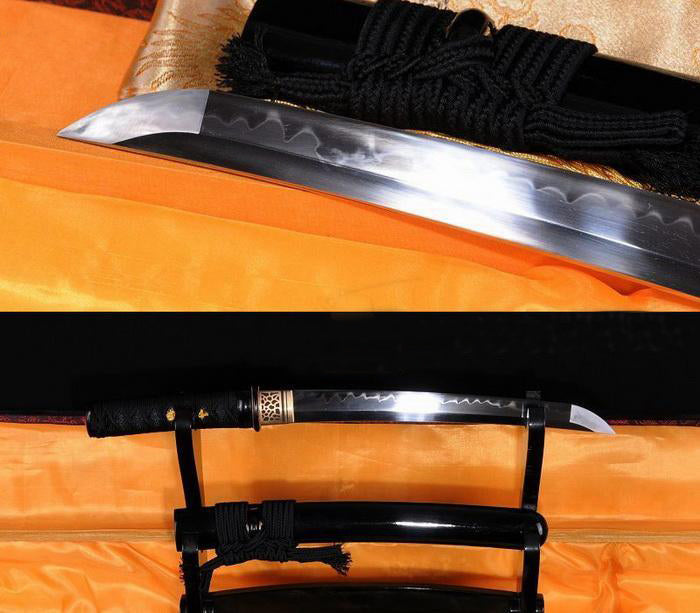 Hand Forged Blade Full Tang Sharp Japanese Samurai Sword Tanto
Hand Forged Blade Full Tang Sharp Japanese Samurai Sword Tanto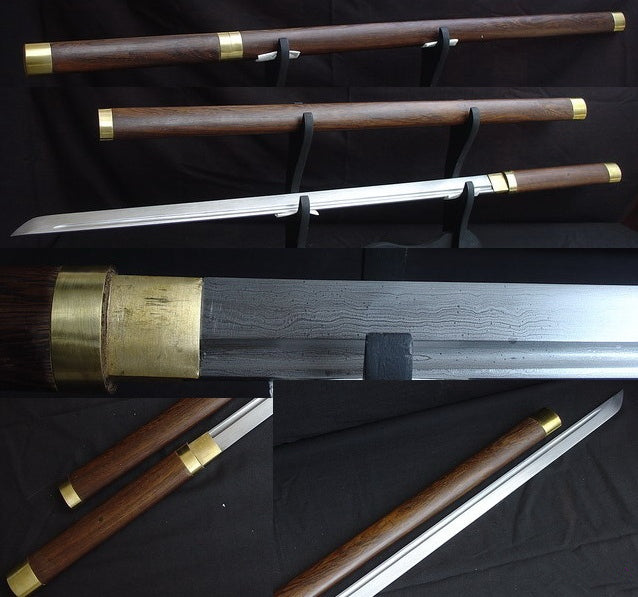 Hand Forged Folded Steel Japanese Samurai Shirasaya Sword Sharp Edge
Hand Forged Folded Steel Japanese Samurai Shirasaya Sword Sharp Edge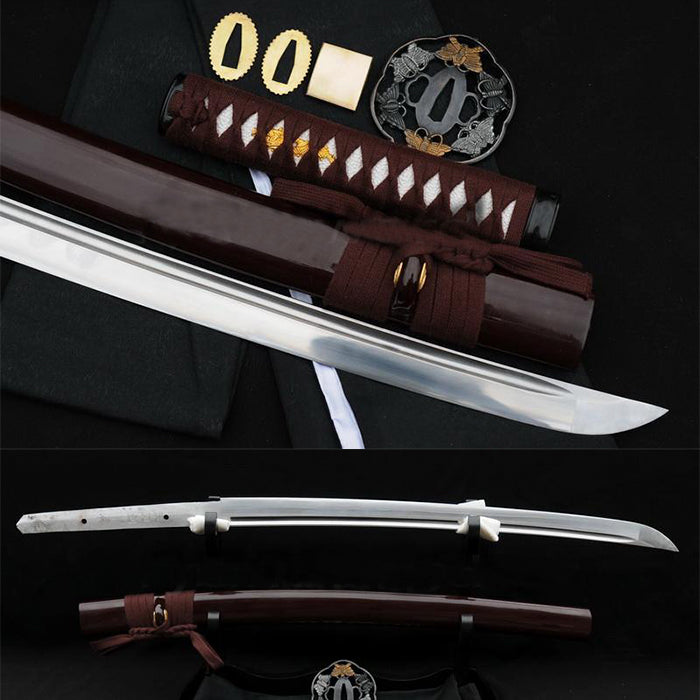
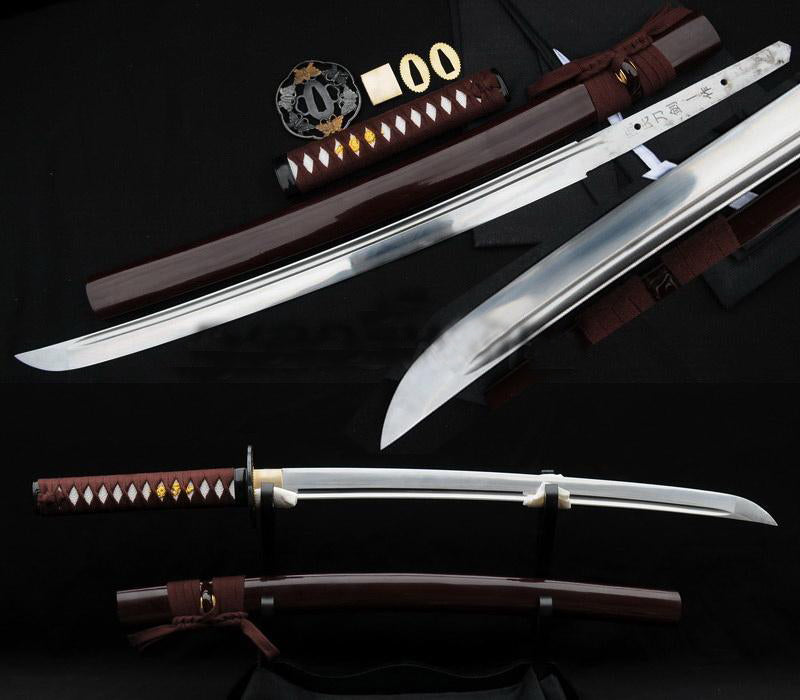 Hand Forged Butterfly Tsuba Japanese Samurai Wakizashi Sword Carbon Steel Blade
Hand Forged Butterfly Tsuba Japanese Samurai Wakizashi Sword Carbon Steel Blade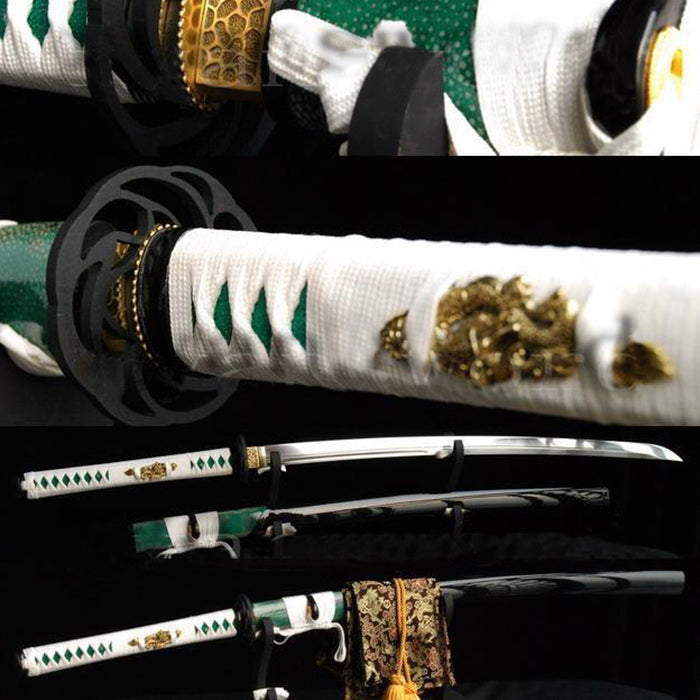
 Hand Forged Blade Japanese Sword Samurai Katana Shark Skin Saya
Hand Forged Blade Japanese Sword Samurai Katana Shark Skin Saya








